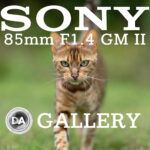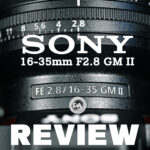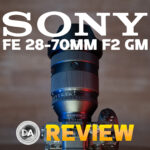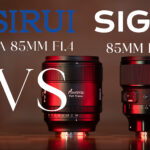
Sony 85mm F1.4 GM II Review
People have been waiting for the Mark II version of the Sony 85mm G Master lens for a long time. There has been a lot of conjecture over whether or not it will be an 85mm F1.2 lens to match the 50mm F1.2 GM that I reviewed here and to compete with similar lenses from Canon or Nikon. But Sony has done their internal calculations and determined that the best way forward for them is a less extreme F1.4 design that will instead be a match for the 24mm F1.4, 35mm F1.4, and 50mm F1.4 GM lenses, and the new Sony FE 85mm F1.4 GM II is a definite match in terms of size, design, and aesthetic to those lenses. This also allowed them to keep the price at a more moderate level at $1799 USD, which will almost certainly result in higher sales. But the market is also pretty saturated at the 85mm focal length on Sony E-mount, so will the 85GM II (as we’ll call it for brevity here) be able to stand out amongst the competing lenses at lower price points? We’ll do our best to explore that amongst other things in our review today. You can watch the video review below or just keep reading.
Follow Me @ YouTube | Patreon | Instagram | Facebook | DA Merchandise | Flickr | 500px | X
Thanks to Sony USA for sending me a review loaner of this lens. As always, this is a completely independent review. *The tests and most of the photos that I share as a part of my review cycle have been done with the Sony a7RV along with the Sony Alpha 1 that serve as my benchmark cameras for Sony lenses.
__________________________________________________________________________________________________
The original Sony 85mm GM (standing for Gold Master, Sony’s premium line of lenses), was released very early on in Sony’s mirrorless journey (early 2016), and while it was a very good lens (I reviewed it in 2019 here), it definitely showed some clear flaws even when compared to the competition of the day. Autofocus in particular showed some lack of refinement and was outclassed in my tests by the much less expensive Sony FE 85mm F1.8. After 8 1/2 years it was clearly time for an update, and Sony has returned with a smaller, lighter, faster, and optically superior lens.

The big challenge is going to be the competition. Samyang has released a MK II version of their 85mm F1.4 lens (my review here), and an even more direct competitor now exists in Sigma’s 85mm F1.4 DN (my review here). There are also a number of 85mm F1.8 options, many of which are very good. I purchased the Sigma years ago and value its strong performance, and because I have it on hand, I will do some direct comparisons to that lens.

So has Sony done enough with the 85GM II to set it apart from the competition? We’ll do our best to unravel that mystery in our review.
Build and Handling
Clearly one of Sony’s priorities was to reduce the size and weight from the original GM lens. Sony has been very successful in this regard in recent years largely because they have had some optical design breakthroughs (the ability to craft certain glass elements that were previously impossible) and by also reducing the size of the focus motors and making them more efficient in design. Sony is touting the fact that the new 85GM II is 20% lighter than the previous generation lens and 13% smaller. That’s obviously a significant size reduction. The overall dimensions of the 85GM II are 84.7 x 107.3mm, or 3.3 x 4.2”. The weight is 642g (22.7oz), which is a full 180g less than the first generation lens.

This is still a little heavier (though only by 17g) and longer (by about 11mm) than the Sigma DN, though now this previous Sigma advantage is significantly reduced. Neither of these differences is big enough to be a deterrent for potential buyers, as the lenses are roughly the same size and weight.



The filter threads up front remain 77mm, which is typically the standard size for many 85mm F1.4 lenses.

Sony’s GM lenses have always been feature rich, though their recent standard has added a couple of new features that are present here and were missing on the previous lens. A lot of the GM features are designed around aperture control in an attempt to make lenses useful for both photo and video capture. There is an aperture ring that gives you the option of having clicks at one third aperture stops, with full stops marked on the aperture ring.

You can also choose a declick option from a switch on the right side of the lens, and this will allow you to smoothly move through the aperture without any preset stops. This is most useful for doing aperture racks during video.

What’s new here is the inclusion of an “Iris Lock” switch that will allow you to either lock into or out of the manual aperture ring. Some people prefer using the aperture ring and don’t want to mistakenly go past F16 (minimum aperture) and into the “Auto” position. This might be most common when doing aperture racks. Other people don’t particularly like using an aperture ring, and the iris lock can assure that they don’t get inadvertently bumped into the manual aperture ring.

Moving a little further up the barrel and you’ll find an AF | MF switch along with two Focus Hold/Function buttons whose function can be defined in camera. One button is on the left side of the barrel, and the other on top to allow a button to be close to hand whether shooting in landscape or portrait orientation.

The aperture iris itself has eleven rounded blades, ensuring that specular highlights remain rounded when the aperture is closed down.

The manual focus ring does have a linear response (focus distances will be repeatable), though I find the damping on the ring itself to be too light. There isn’t a lot of feel during manual focus, and thus it doesn’t feel like a true manual focus emulation to me.

·The 85GM II has a thorough weather sealing including rear gasket, internal seals on all seams, buttons, and switches, and a fluorine coating on the front.
The minimum focus distance = 85cm (AF) or 80cm (MF), and the maximum magnification is just 0.12x, which is on the low side of average for an 85mm lens (and is tied with the Sigma)

I already own the Sony 35mm and 50mm F1.4 GM lenses, and the new 85GM II feels like a very natural extension of that series in terms of size, features, and handling.

Autofocus and Video
One of the greatest areas of weakness for the original 85mm F1.4 GM lens was its autofocus. I wasn’t covering Sony when it was released in 2016, but I did do a big six way comparison in 2019 where I compared six auto focusing 85mm E-mount options, including the GM, Sony 85mm F1.8, Sigma 85mm F1.4 ART (the big one), Samyang AF 85mm F1.4, Zeiss Batis 85mm F1.8, and Viltrox AF 85mm F1.8. The GM lens surprised me due to its rather rough autofocus performance. The focus motor didn’t feel particularly refined or fast. It turns out that this was because it had a carryover SSM focus motor, a DSLR era focus motor technology. But Sony has really upped their game since that point, and now we have a radically different focus situation.

The new focus system employs two XD Linear motors, and Sony reports that these are the largest, most powerful XD focus motors every. This results in focus speed that is up to 3x faster than the original GM lens and with subject tracking that is nearly 7x more effective. Focus has been optimized for the 120FPS burst rate of the a9III, which means that this is the rare large aperture prime lens that sports ready.

I shot in a wide variety of situations, and found that I had plenty of focus speed regardless of what I was shooting. I could track these ducks flying over a pond without issue, for example:



If we punch into one of those shots (all shot at F1.4, by the way), we can see that each frame is perfectly focused despite the fast moving subject and complex background.


I shot exclusively with the lens at a 50th wedding anniversary celebration for friends, and I had flawless results in mixed indoor lighting



I shot a photo of a caterpillar walking on concrete, and even when shooting at F1.4 you can see the great detail and focus accuracy when viewing at high magnification.


Sony wants to be sure that their whole G Master lineup is ready to capture action, and the 85GM II joins the ranks of fast and accurately focusing premium lenses. We’re a long way from the Canon EF 85mm F1.2L II that was extremely “leisurely” in focus speed; how quickly we forget what the standard was like in the not very distant past. Autofocus for stills is vastly improved here in every way over the first generation GM lens. I was actually able to acquire bees in flight and focus on them, and if you know how quickly they are moving, and how small they are, that’s truly mind blowing.


Sony also recognizes that the modern mirrorless camera market is a hybrid one. It is just as important that lenses be able to function well in a video environment. I found that the 85GM II was a stable and effective video companion. Focus pulls were confident, smooth, and well damped.

I also found that my hand test (where I alternatively block the camera’s view of my face with my hand and then move it out of the way) went well, with smooth transitions to and from my hand.
Focus breathing is well controlled for a longer focal length. I also found that real world transitions from one subject to another were well damped. They are fairly quick, but not abrupt. They have a reasonably cinematic feel to them, and the low focus breathing helps those transitions to not feel jarring.

Video footage, as you would expect, is very sharp and detailed. I’ve been secretly using the lens to film my YouTube videos over the past month, and it has been perfectly reliable in filming in those situations.
Autofocus is a huge area of improvement here, and it is safe to say that this is the best focusing 85mm lens that I’ve ever used. Even Canon’s current premium RF 85mm F1.2L feels pretty rough in comparison.
Image Quality Breakdown
The original Sony 85mm F1.4 GM had an optical design of 11 elements in 8 groups, with one XA (Sony’s special eXtreme Aspherical element) and three ED (Extra low Dispersion) elements. The new 85GM II has a more complex optical design with 14 elements in 11 groups. There is a new XA element (bringing the total to two) and two ED elements in the design.

This is a very high resolution lens, producing highly detailed images that hold up even at high levels of magnification. I shot primarily on a 61MP a7RV body, and this lens had zero problems resolving that level of resolution…even at F1.4:


As you might expect, Sony had worked hard to correct for the typical aberrations and optical flaws, though hopefully without also eliminating all the character of the lens. Here’s a look at how the lens handles vignette and distortion.

Distortion is one clear area of advantage versus the Sigma 85mm F1.4 DN, which suffers from a surprisingly severe amount of pincushion distortion (a -11 to correct). The 85GM II needed only a -3 to correct a tiny amount of pincushion distortion, and for portraits it would probably be more flattering to leave it uncorrected.
Vignette is also fairly well managed, needing only a +30 to correct. That’s just around one stop, which as you can see from the original is so minimal as to not really need correction either.
I also found that longitudinal chromatic aberrations (LoCA) were well controlled, with very little color fringing before or after the plane of focus.

This combined with high levels of resolution and contrast allow for fine textures to really pop in images even at F1.4:


The same was true of lateral chromatic aberrations (LaCA) that show up near the edges of the frame in transition zones. I see a clean transition from black to white near the edge of the frame here.

So far so good. How about resolution? I’m using a 61MP Sony a7RV here and will show results at or near 200% magnification levels. Here’s a look at the test chart that the crops will come from:

And here at the F1.4 crops from the center, mid-frame, and bottom right corner.



You can see very consistent sharpness from the center out to the very edge of the frame.
As soon as I saw that the USPS was releasing a set of Ansel Adams commemorative stamps, I knew that I needed to get them for my test charts. They are both small and have good print quality (of timeless images), so I thought they would make a nice addition to my test chart. If I choose one of the stamps near the center of the frame and compare to the far left side (the right side is represented in the crops above), we can see that other than a bit less contrast, the resolution level looks pretty similar between the two extremes.

Stopping down to F2 introduces even more sharpness and contrast. You can see that the resolution in the mid-frame is just exceptionally good.

Real world images show awesome detail.


Even when shooting a difficult landscape scene at F1.4 on 61MP you can see that the lens is capable of producing incredible levels of detail. You can see tiny golf carts at various places in the crop of this shot.


Landscape images are just as detailed as you would expect at apertures of F4-F8. Here’s a lovely shot at F5.6:

Resolution is never going to be problem here. It is basically flawless from F1.4 on.
Diffraction on a high resolution body will typically begin by F8 and becomes slightly more apparent by F11. After F11, however, diffraction becomes much more noticeable, with the effects of diffraction being very obvious by the minimum aperture of F16.

The challenge for highly corrected lenses with high contrast is to not lose the character of the lens due to overcorrection. Often the lenses with the most “magical” rendering are not perfectly corrected and retain a few flaws. There are, however, rare exceptions to this rule. Some lenses manage to find the sweet spot between high contrast and beautiful rendering. The 85GM II does fairly well in this regard, but I would say that the overall rendering is more technically excellent than artistic.

This image felt like there was nicer bokeh than some others, as it handled the foreground bokeh quite well.

But it was rare that I found the bokeh just purely creamy. I felt like there was often a little more outlining than what I would like.

So I would say that background bokeh is good:

…but foreground bokeh is nicer than average.

I would say that this is still an area where I would slightly favor the Sigma DN, however, as I feel like the bokeh is just a little softer.

Often large aperture lenses struggle with flare, but the 85GM II is not one of them. It handled direct shots into the sun without issue. The F1.4 image (first in series) is overexposed (because F1.4 in direct sunlight doesn’t work too well!), but you can see an absence of ghosting or veiling issues in the series.



In general, the most egregious thing I can come up with optically is that I don’t always find the rendering as “magical” as some 85mm lenses I’ve tested, but that’s probably still stretching things. And a lens that is this sharp at F1.4 is probably going to endear itself to a LOT of people.


If you want to see more images, check out the image gallery linked here.
Conclusion
The Sony FE 85mm F1.4 G Master II lens has been long anticipated. It is replacing the oldest G Master prime lens in the lineup, a lens that was under serious threat from many new competitors along the way. And while the 85GM II is a lens improved in every way, I think that Sony might have missed an opportunity to create a standout lens by swinging for the fences with an F1.2 lens. There are some really solid 85mm lenses optically available for far less, with both the Samyang AF 85mm F1.4 II and the Sigma 85mm F1.4 DN ART being the standouts. The Sigma, in particular, isn’t really much behind in performance or features, but happens to cost a good $600+ less. And while there once was a time when certain photographers were a little “snobbish” towards third party brands like Sigma, I think that Sigma has largely overcome that. That makes the $1800 USD price tag of the new GM lens a bit of a harder sell, no matter how good it is.

In fact, there is only one clear area that I think the GM II lens distinguishes itself, and that is in terms of autofocus. Much like the Samyang AF 135mm F1.8 vs the Sony 135mm F1.8 GM, when the subject is still, there’s not a lot of advantage to the Sony over the third party lens. But when a subject is in motion, the high end autofocus system of the 85GM II (or the 135GM) means that you are going to get a lot more keepers. Take a look at this shot, literally taken with the camera held low while trying to scuttle backwards away from a cat who wouldn’t stay still long enough for me to get in place.

But look at that focus, and thus the resulting detail that perhaps exceeds what other lenses could achieve even if the target were standing still.

And that is the main thing that sets the Sony 85GM II apart. If you want to be able to capture amazing images on the edges (fast moving subjects, low light, etc…), then the Sony FE 85mm F1.4 GM II might just be worth the extra money. And for those who own the original GM, the new lens is smaller, lighter, faster, sharper, and better corrected. If you can get good value for your original GM, it is probably well worth the upgrade. For everyone else, the choice is more convoluted, because in all of the history of photography, no one has ever been more spoiled for choice than Sony E-mount shooters.

Pros:
- Smaller and lighter
- A few more features
- Thorough weather sealing
- Wide range of aperture control options
- Extremely fast autofocus
- Autofocus is smooth and silent
- Extreme precision even with fast moving targets
- Low focus breathing
- Extremely sharp wide open
- No fringing
- Low vignette
- Low distortion
- Good flare resistance
- Nice bokeh
Cons:
- Only F1.4
- More expensive than very competent competitors
_________________________________________________________________________
GEAR USED:
Purchase the Sony FE 85mm F1.4 GM II @ B&H Photo | Adorama | Amazon | Camera Canada | Sony Canada | Amazon Canada | Amazon UK | Amazon Germany
___________________________________________________________________
Purchase the Sony a7RV @ B&H Photo | Adorama | Amazon | Camera Canada | Sony Canada | Amazon Canada | Amazon UK | Amazon Germany
__________________________________________________________________
Purchase the Sony a7IV @ B&H Photo | Adorama | Amazon | Camera Canada | Sony Canada | Amazon Canada | Amazon UK | Amazon Germany
_________________________________________________________________
Purchase the Sony Alpha 1 @ Camera Canada | B&H Photo | Adorama | Amazon | Sony Canada | Amazon Canada | Amazon UK | Amazon Germany | Ebay
_________________________________________________________________
Want to support this channel? Use these affiliate links to shop at: B&H Photo | Amazon | Adorama | Camera Canada | Amazon Canada | Amazon UK | Ebay | Make a donation via Paypal
Buy DA Merchandise https://bit.ly/TWIMerch

Keywords: 85mm F1.4 GM II, Sony FE 85mm F1.4 GM II, 85 GM II, GM, II, F1.4, 85mm, Full Frame, Review, Sony Alpha 1, Sony a7RV, Review, Hands On, Dustin Abbott, Real World, Comparison, Sharpness, Bokeh, Flare Resistance, Autofocus, Image Quality, Sample Images, Video, Photography, let the light in, weathersealing, #letthelightin, DA










